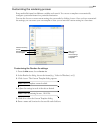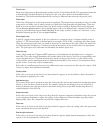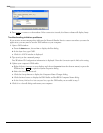
316
SAVING, RENDERING, AND PRINTING PROJECTS CHP. 17
Rendering with networked computers
This feature is available only in the full version of Vegas software.
Network rendering allows you to designate a specific computer to render the entire output file, or you can
distribute a single rendering job among several computers.
• Distributed network rendering splits the video into segments that are rendered by multiple computers. In
this mode, each computer renders a portion of the project, and the rendered sections are then reassembled
into a single file by the one computer (called the stitch host).
Distributed rendering is a good way to reduce the time it takes to render a project containing a significant
amount of processed video (video effects, transitions, panning/cropping, track motion, and compositing).
However, distributed rendering requires increased disk space and network traffic because each segment
must be saved before the final output can file be generated.
Nontemporal video output formats, such as DV or uncompressed AVI, are also well suited for distributed
network rendering because segments can be reassembled without re-encoding.
• Nondistributed network rendering behaves very much like standard rendering, but you can choose which
computer you want to render the project. In this mode, each computer renders a complete file from a
Vegas project or the loop region.
If you want to encode the same project to multiple streaming formats and bit rates, it is best to queue up
multiple nondistributed jobs because streaming formats use temporal compression and you can assign
different renderers to different output formats. If you have a project or output format with audio only,
choose nondistributed rendering because only video is rendered in the first phase of a distributed job.
Both distributed and nondistributed rendering jobs can be queued to be performed as computing resources
become available so you can render multiple projects or render the same project in multiple formats.
Rendering using a computer other than your main editing computer allows you to continue working without
waiting for the render job to complete.
Setting up your computers for network rendering
The computer that initiates and manages a network render is considered the owner of the job. Each
networked computer that you use for rendering is called a renderer. The computer that reassembles rendered
segments in a distributed rendering job is called the stitch host. The computer that is designated to perform a
nondistributed network render job is called the render host.
To use network rendering effectively, we recommend the following:
• 256 MB RAM in each renderer.
• 100 Mbps switched local area network.
• Your media files and output file must be in shared folders, preferably on a dedicated file server, All
renderers must have permission to read, write, create, and delete files in the shared folders.
Before network rendering begins, a copy of your project will be saved in the shared output folder for use by
the renderers. This version will have all media paths remapped based on the Network Render Service file
mappings. For more information, see Setting file mappings on page 321.


















